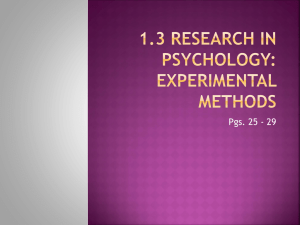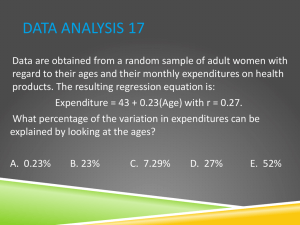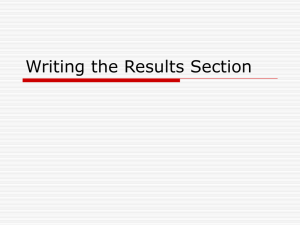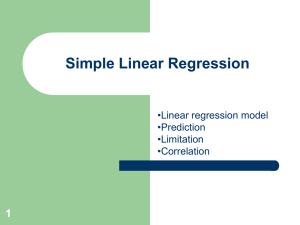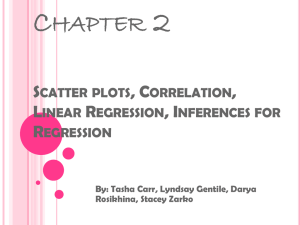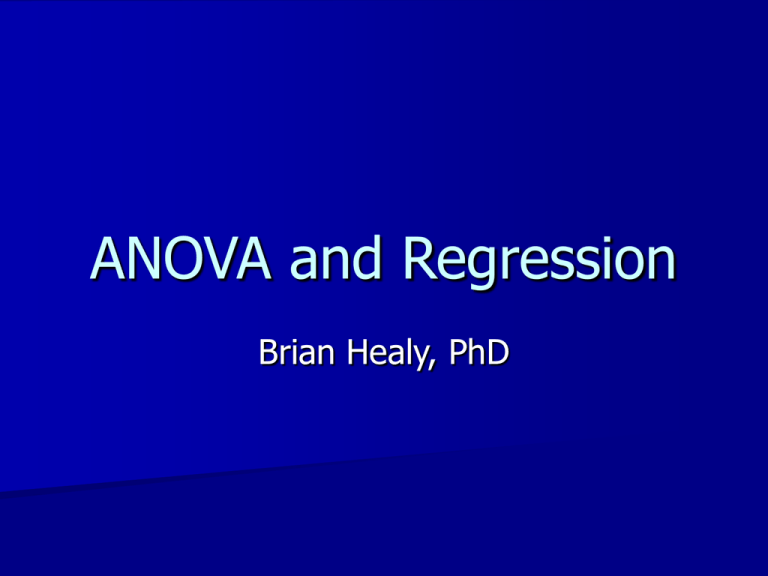
ANOVA and Regression
Brian Healy, PhD
Objectives
ANOVA
– Multiple comparisons
Introduction to regression
– Relationship to correlation/t-test
Comments from reviews
Please fill them out because I read them
More examples and not just MS
More depth on technical details/statistical
theory/equations
– First time ever!!
– I have made slides from more in depth
courses available on-line so that you have
access to formulas for t-test, ANOVA, etc.
Talks too fast for non-native speakers
Review
Types of data
p-value
Steps for hypothesis test
– How do we set up a null hypothesis?
Choosing the right test
– Continuous outcome variable/dichotomous
explanatory variable: Two sample t-test
Steps for hypothesis testing
State null hypothesis
State type of data for explanatory and
outcome variable
Determine appropriate statistical test
State summary statistics
Calculate p-value (stat package)
Decide whether to reject or not reject the null
hypothesis
1)
2)
3)
4)
5)
6)
•
7)
NEVER accept null
Write conclusion
Example
In previous class, two groups were
compared on a continuous outcome
What if we have more than two groups?
Ex. A recent study compared the intensity
of structures on MRI in normal controls,
benign MS patients and secondary
progressive MS patients
Question: Is there any difference among
these groups?
Two approaches
Compare each group to each other group
using a t-test
– Problem with multiple comparisons
Complete global comparison to see if
there is any difference
– Analysis of variance (ANOVA)
– Good first step even if eventually complete
pairwise comparisons
Types of analysis-independent
samples
Outcome
Explanatory
Analysis
Continuous
Dichotomous
t-test, Wilcoxon
test
Continuous
Categorical
Continuous
Continuous
ANOVA, linear
regression
Correlation, linear
regression
Dichotomous
Dichotomous
Chi-square test,
logistic regression
Dichotomous
Continuous
Logistic regression
Time to event
Dichotomous
Log-rank test
Global test-ANOVA
As a first step, we can compare across all
groups at once
The null hypothesis for ANOVA is that the
means in all of the groups are equal
ANOVA compares the within group
variance and the between group variance
– If the patients within a group are very alike
and the groups are very different, the groups
are likely different
Hypothesis test
1)
2)
3)
4)
5)
6)
7)
H0: meannormal=meanBMS=meanSPMS
Outcome variable: continuous
Explanatory variable: categorical
Test: ANOVA
meannormal=0.41; meanBMS= 0.34;
meanSPMS=0.30
Results: p=0.011
Reject null hypothesis
Conclusion: At least one of the groups is
significantly different than the others
Technical aside
Our F-statistic is the ratio of the between group
variance and the within group variance
n x x
k
2
between
2
within
s
F
s
n 1s
1
2
1
i 1
2
i
i
nk 1sk2
k 1
n 1 n
1
k
1
This ratio of variances has a known distribution (Fdistribution)
If our calculated F-statistic is high, the between group
variance is higher than the within group variance,
meaning the differences between the groups are not
likely due to chance
Therefore, the probability of the observed result or
something more extreme will be low (low p-value)
This is the
distribution under the
null
This small shaded
region is the part of
the distribution that
is equal to or more
extreme than the
observed value.
The p-value!!!
Now what
The question often becomes which groups
are different
Possible comparisons
– All pairs
– All groups to a specific control
– Pre-specified comparisons
If we do many tests, we should account
for multiple comparisons
Type I error
Type I error is when you reject the null
hypothesis even though it is true
(a=P(reject H0|H0 is true))
We accept making this error 5% of the
time
If we run a large experiment with 100
tests and the null hypothesis was true in
each case, how many times would we
expect to reject the null?
Multiple comparisons
For this problem, three comparisons
– NC vs. BMS; NC vs. SPMS; BMS vs. SPMS
If we complete each test at the 0.05 level, what
is the chance that we make a type I error?
– P(reject at least 1 | H0 is true) = a
– P(reject at least 1 | H0 is true) = 1- P(fail to reject all
three| H0 is true) = 1-0.953 = 0.143
Inflated type I error rate
Can correct p-value for each test to maintain
experiment type I error
Bonferroni correction
The Bonferroni correction multiples all pvalues by the number of comparisons completed
– In our experiment, there were 3 comparisons, so we
multiply by 3
– Any p-value that remains less than 0.05 is significant
The Bonferroni correction is conservative (it is
more difficult to obtain a significant result than it
should be), but it is an extremely easy way to
account for multiple comparisons.
– Can be very harsh correction with many tests
Other corrections
All pairwise comparisons
– Tukey’s test
All groups to a control
– Dunnett’s test
MANY others
False discovery rate
Example
For our three-group comparison, we compare
each and get the following results from Tukey’s
test
Groups
NC vs. BMS
NC vs. SPMS
BMS vs. SPMS
Mean diff
0.075
0.114
0.039
p-value
0.10
0.012
0.60
Significant
*
Questions to ask yourself
What is the null hypothesis?
We would like to test the null hypothesis
at the 0.05 level
If well defined prior to the experiment, the
correction for multiple comparison if
necessary will be clear
Hypothesis generating vs. hypothesis
testing
Conclusions
If you are doing a multiple group comparison,
always specify before the experiment which
comparisons are of interest if possible
If the null hypothesis is that all the groups are
the same, test global null using ANOVA
Complete appropriate additional comparisons
with corrections if necessary
No single right answer for every situation
Types of analysis-independent
samples
Outcome
Explanatory
Analysis
Continuous
Dichotomous
t-test, Wilcoxon
test
Continuous
Categorical
Continuous
Continuous
ANOVA, linear
regression
Correlation, linear
regression
Dichotomous
Dichotomous
Chi-square test,
logistic regression
Dichotomous
Continuous
Logistic regression
Time to event
Dichotomous
Log-rank test
Correlation
Is there a linear
relationship between
IL-10 expression and
IL-6 expression?
The best graphical
display for this data is
a scatter plot
Correlation
Definition: the degree to which two continuous
variables are linearly related
– Positive correlation- As one variable goes up, the
other goes up (positive slope)
– Negative correlation- As one variable goes up, the
other goes down (negative slope)
Correlation (r) ranges from -1 (perfect negative
correlation) to 1 (perfect positive correlation)
A correlation of 0 means that there is no linear
relationship between the two variables
Positive correlation
Negative correlation
12
12
10
10
8
8
6
6
4
4
2
2
0
0
0
2
4
6
8
10
12
0
No correlation
2
4
6
8
10
12
No correlation (quadratic)
10
18
9
16
8
14
7
12
6
10
5
4
8
3
6
2
4
1
2
0
0
2
4
6
8
10
12
0
0
2
4
6
8
10
Hypothesis test
1)
2)
3)
4)
5)
6)
7)
H0: correlation between IL-10 expression and
IL-6 expression=0
Outcome variable: IL-6 expression- continuous
Explanatory variable: IL-10 expressioncontinuous
Test: correlation
Summary statistic: correlation=0.51
Results: p=0.011
Reject null hypothesis
Conclusion: A statistically significant correlation
was observed between the two variables
Technical aside-correlation
The formal definition of the correlation is given by:
Cov( x, y)
Corr( x, y)
Var( x) Var( y)
Note that this is dimensionless quantity
This equation shows that if the covariance between the
two variables is the same as the variance in the two
variables, we have perfect correlation because all of the
variability in x and y is explained by how the two
variables change together
How can we estimate the
correlation?
The most common estimator of the correlation is the
Pearson’s correlation coefficient, given by:
x x y y
n
r
i 1
i
i
n
2
2
n
xi x yi y
i 1
i 1
This is a estimate that requires both x and y are normally
distributed. Since we use the mean in the calculation, the
estimate is sensitive to outliers.
Distribution of the test statistic
The standard error of the sample correlation
coefficient is given by
1 r 2
sˆe(r )
n2
The resulting distribution of the test statistic is a
t-distribution with n-2 degrees of freedom where
n is the number of patients (not the number of
measurements)
r 0
n2
t
r
2
2
1
r
1 r
n2
Regression-Everything in one place
All analyses we have done to this point
can be completed using regression!!!
Quick math review
As you remember, the
equation of a line is
y=mx+b
For every one unit
increase in x, there is
an m unit increase in
y
b is the value of y
when x is equal to
zero
Line
20
18
16
y = 1.5x + 4
14
12
10
8
6
4
2
0
0
2
4
6
8
10
12
Picture
Does there seem to
be a linear
relationship in the
data?
Is the data perfectly
linear?
Could we fit a line to
this data?
25
20
15
10
5
0
0
2
4
6
8
10
12
How do we find the best line?
Linear regression tries
to find the best line
(curve) to fit the data
Let’s look at three
candidate lines
Which do you think is
the best?
What is a way to
determine the best
line to use?
What is linear regression?
The method of finding
the best line (curve)
is least squares,
which minimizes the
distance from the line
for each of points
The equation of the
line is y=1.5x + 4
25
20
y = 1.5x + 4
15
10
5
0
0
2
4
6
8
10
12
Example
For our investigation of the
relationship between IL-10
and IL-6, we can set up a
regression equation
IL6i b0 b1 * IL10i e i
b0 is the expression of IL-6
when IL-10=0 (intercept)
b1 is the change in IL-6 for
every 1 unit increase in IL-10
(slope)
ei is the residual from the line
The final regression equation is
IL6ˆ 26.4 0.63* IL10
The coefficients mean
– the estimate of the mean expression of IL-6 for a
patient with IL-10 expression=0 (b0)
– an increase of one unit in IL-10 expression leads to
an estimated increase of 0.63 in the mean
expression of IL-6 (b1)
Tough question
In our correlation hypothesis test, we wanted to
know if there was an association between the
two measures
If there was no relationship between IL-10 and
IL-6 in our system, what would happen to our
regression equation?
– No effect means that the change in IL-6 is not related
to the change in IL-10
– b1=0
Is b1 significantly different than zero?
Hypothesis test
1)
2)
3)
4)
5)
6)
7)
H0: no relationship between IL-6 expression
and IL-10 expression, b1 =0
Outcome variable: IL-6- continuous
Explanatory variable: IL-10- continuous
Test: linear regression
Summary statistic: b1 = 0.63
Results: p=0.011
Reject null hypothesis
Conclusion: A significant correlation was
observed between the two variables
Wait a second!!
Let’s check something
– p-value from correlation analysis = 0.011
– p-value from regression analysis = 0.011
– They are the same!!
Regression leads to same conclusion as
correlation analysis
Other similarities as well from models
Technical aside-Estimates of
regression coefficients
Once we have solved the least squares equation,
we obtain estimates for the b’s, which we refer
n
to bˆ0 , bˆ1 as
bˆ1
x x y y
i 1
i
i
x x
n
i 1
2
i
bˆ0 y bˆ1 x
To test if this estimate is significantly different
than 0, we use the following equation:
bˆ1 b1
t
seˆ bˆ1
Assumptions of linear regression
Linearity
– Linear relationship between outcome and predictors
– E(Y|X=x)=b0 + b1x1 + b2x22 is still a linear regression
equation because each of the b’s is to the first power
Normality of the residuals
– The residuals, ei, are normally distributed, N(0, s2
Homoscedasticity of the residuals
– The residuals, ei, have the same variance
Independence
– All of the data points are independent
– Correlated data points can be taken into account
using multivariate and longitudinal data methods
Linear regression with dichotomous
predictor
Linear regression can also be used for
dichotomous predictors, like sex
Last class we compared relapsing MS patients to
progressive MS patients
To do this, we use an indicator variable, which
equals 1 for relapsing and 0 for progressive. The
resulting regression equation for expression is
exi b0 b1 * Ri e i
Interpretation of model
The meaning of the coefficients in this case are
– b0 is the estimate of the mean expression when
R=0, in the progressive group
– b0 b1 is the estimate of the mean expression when
R=1, in the relapsing group
– b1 is the estimate of the mean increase in
expression between the two groups
The difference between the two groups is b1
If there was no difference between the groups,
what would b1 equal?
Mean in wildtype=b0
Difference between
groups=b1
Mean in Progressive
group=b0
Hypothesis test
1)
2)
3)
4)
5)
6)
7)
Null hypothesis: meanprogressive=meanrelapsing
(b1=0)
Explanatory: group membership- dichotomous
Outcome: cytokine production-continuous
Test: Linear regression
b1=6.87
p-value=0.199
Fail to reject null hypothesis
Conclusion: The difference between the
groups is not statistically significant
T-test
As hopefully you remember, you could
have tested this same null hypothesis
using a two sample t-test
Very similar result to previous class
If we would have assumed equal variance
for our t-test, we would have gotten to the
same result!!!
ANOVA results can also be tested using
regression using more than one indicator
Multiple regression
A large advantage of regression is the ability to
include multiple predictors of an outcome in one
analysis
A multiple regression equation looks just like a
simple regression equation.
Y b0 b1x1 b2 x2 ... bn xn e
Example
Brain parenchymal fraction (BPF) is a
measure of disease severity in MS
We would like to know if gender has an
effect on BPF in MS patients
We also know that BPF declines with age in
MS patients
Is there an effect of sex on BPF if we
control for age?
.95
.9
.8
BPF
.85
.75
0
.2
.4
.6
Sex
Blue=males; Red=females
.8
1
.95
.9
.75
.8
BPF
.85
20
30
40
Age
50
Blue=males; Red=females
60
Is age a potential confounder?
We know that age has an effect on BPF
from previous research
We also know that male patients have a
different disease course than female
patients so the age at time of sampling
may also be related to sex
Age
Sex
BPF
Model
The multiple linear regression model
includes a term for both age and sex
BPFi b0 b1 * genderi b2 * agei e i
What are the values genderi takes on?
– genderi=0 if the patient is female
– genderi=1 if the patient is male
Expression
Females:
– BPFi = b0+ b2*agei+ei
Males:
– BPFi = (b0+ b1)+ b2*agei+ei
What is different about the equations?
– Intercept
What is the same?
– Slope
This model allows an effect of gender on the
intercept, but not on the change with age
Interpretation of coefficients
The meaning of each coefficient
– b0: the average BPF when age is 0 and the patient is
female
– b1: the average difference in BPF between males and
female, HOLDING AGE CONSTANT
– b2: the average increase in BPF for a one unit
increase in age, HOLDING GENDER CONSTANT
Note that the interpretation of the coefficient
requires mention of the other variables in the
model
Estimated coefficients
Here is the estimated regression equation
BPFˆi 0.942 0.017* sexi 0.0026* agei
The average difference between males and
females is 0.017 holding age constant
For every one unit increase in age, the mean BPF
decreases 0.0026 units holding sex constant
Are either of these effects statistically significant?
– What is the null hypothesis?
Hypothesis test
1)
2)
3)
4)
5)
6)
7)
H0: No effect of sex, controlling for age b1 =0
Continuous outcome, continuous predictor
Linear regression controlling for sex
Summary statistic: b1 =0.017
p-value=0.37
Since the p-value is more than 0.05, we fail to
reject the null hypothesis
We conclude that there is no significant
association between sex and BPF controlling
for age
Hypothesis test
1)
2)
3)
4)
5)
6)
7)
H0: No effect of age, controlling for sex b2 =0
Continuous outcome, continuous predictor
Linear regression controlling for sex
Summary statistic: b2 =-0.0026
p-value=0.00 4
Since the p-value is less than 0.05, we reject
the null hypothesis
We conclude that there is a significant
association between age and BPF controlling
for sex
Estimated effect
of sex
Estimated effect
of age
p-value for sex
p-value for age
20
30
40
Age
50
60
.75
.8
BPF
.85
.9
.95
Conclusions
Although there was a marginally
significant association of sex and BPF, this
association was not significant after
controlling for age
The significant association between age
and BPF remained statistically significant
after controlling for sex
What we learned (hopefully)
ANOVA
Correlation
Basics of regression

